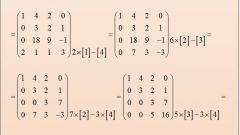You will need
- paper;
- - handle.
Instruction
1
Using only basic definitions to check linear independence of a system of vector-columns, respectively, and give a conclusion on the existence of the basis, is very difficult. Therefore, in this case, you may be able to use some special signs.
2
It is known that the vectors are linearly independent if derived from the determinant is not zero.Therefore, it is possible enough to explain the fact that the system of vectors forms a basis. So, in order to prove that the vectors form a basis, should be the coordinates of their determinant and make sure it is not zero.Further, in order to reduce and simplify records, the representation of the vector-column matrix column will replace the transpose by the matrix-line.
3
Example 1. Whether form a basis in R^3 vector-columns (1, 3, 5)^T, (2, 6, 4)^T, (3, 9, 0)^T. the Solution. Make up a determinant |A|, whose rows are the elements of the specified column (see Fig.1).Expanding this determinant by the rule of triangles, you get: |A| = 0+90+36-90-36-0=0. Therefore, these vectors cannot form a basis.
4
Example. 2. The system of vectors consists of (10, 3, 6)^T, (1, 3, 4)^T, (3, 9, 2)^T. if they Can form a basis?Solution. By analogy with the first example, make a key (see Fig.2): |A| =60+54+36-54-360-6=270, ie is not zero. Therefore, this system is a vector-column suitable for use as the basis in R^3.
5
Now obviously becomes clear, that for finding of the basis system of the vector-column is sufficient to take the determinant of any suitable dimension different from zero. Elements its columns form a base system. Moreover, always it is desirable to have a simple basis. Since the determinant of the identity matrix is always nonzero (for any dimension), as the basis you can always choose a system (1, 0, 0,...,0)^T, (0, 1, 0,...,0)^T, (0, 0, 1,...,0)^T,..., (0, 0, 0,...,1)^T.






